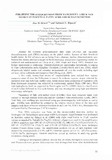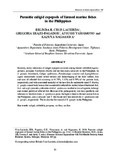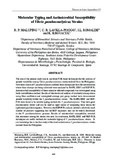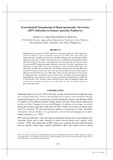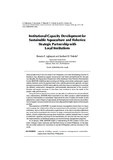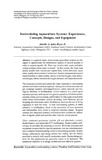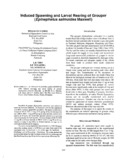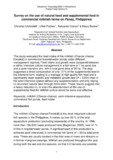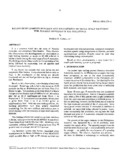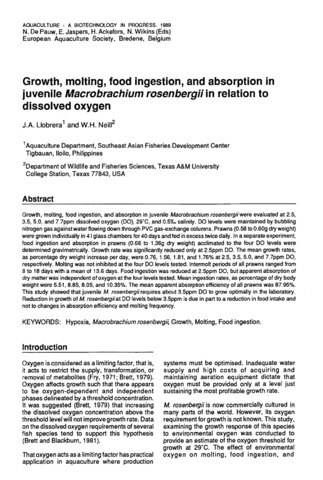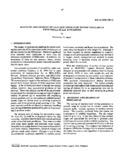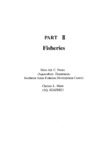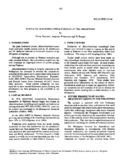Conference Proceedings: Recent submissions
Now showing items 61-80 of 299
-
Philippine thraustochytrids from mangroves: A rich new source of essential fatty acids for human nutrition
(Marine Science Institute, University of the Philippines, 2007) -
Microbial diseases in aquaculture: issues and challenges
(Marine Science Institute, University of the Philippines, 2007)Aquaculture is the farming of aquatic organisms including fish, molluscs, crustaceans and aquatic plants where farming implies some intervention in the rearing process to enhance production, such as regular stocking, ... -
Second International Conference on the Culture of Penaeid Prawns and Shrimps: Proceedings of an International Conference held at Iloilo City from 13-17 May 1996
(Elsevier, 1998)Abstracts of the papers presented at the conference are cited individually. -
Training needs and provision in developing countries of the Asia-Pacific region
(Karger, 2007)Training has played a significant role in the development of capacity in aquatic animal health in the Asia-Pacific region where most specialists have fisheries or a background in biology rather than in veterinary medicine. ... -
Parasitic caligid copepods of farmed marine fishes in the Philippines
(Fish Health Section, Asian Fisheries Society, 2011)Recently, heavy infestation of caligid copepods occurred among farmed rabbitfish Siganus guttatus, pompano Trachinotus blochii and sea bass Lates calcarifer in the Philippines. In S. guttatus broodstock, Caligus epidemicus, ... -
Molecular typing and antimicrobial susceptibility of Vibrio parahaemolyticus strains
(Fish Health Section, Asian Fisheries Society, 2008)The aim of the present study was to use three PCR-based techniques for the analysis of genetic variability among Vibrio parahaemolyticus strains isolated from the Philippines. Seventeen strains of V. parahaemolyticus ... -
Experimental transmission of hepatopancreatic parvovirus (HPV) infection in Penaeus monodon postlarvae
(Fish Health Section, Asian Fisheries Society, 2005)Hepatopancreatic parvovirus (HPV) infection in penaeid shrimps was first reported in various countries of the Asia-Pacific region in mid-1980. The virus affects the hepatopancreas of postlarvae and juveniles, usually leading ... -
Institutional capacity development for sustainable aquaculture and fisheries: Strategic partnership with local institutions
(Terrapub, 2008)Many people living in the rural areas in the Philippines, as in other developing countries in Southeast Asia, depend on aquatic resources for their food and livelihood. For the past two decades, the Aquaculture Department ... -
Recirculating aquaculture systems: experiences, concepts, designs, and equipment
(Philippine Association for the Advancement of Science (PhilAAS), 2002)In a general sense, recirculating aquaculture system are designed tp approximate the fundamental aspects of natural system in order to support aquatic life. They may involve tank, pund, and other culture system where water ... -
Induced spawning and larval rearing of grouper (Epinephelus salmoides Maxwell)
(1986)Broodfish of grouper (Epinephelus salmoides ) were induced to spawn by hormonal induction. The hormones used for this experiment were HCG + pituitary gland (PG) and LRH-a. The results showed that at dosages of 500 IU HCG ... -
Survey on the use of natural food and supplemental feed in commercial milkfish farms on Panay, Philippines
(Stuttgart University, 2000)This study evaluated the feed intake of the milkfish (Chanos chanos Forsskål) in commercial brackishwater ponds under different management regimes. Feed intake and growth were compared between a rather intensive culture ... -
Development of broodstock for small-scale shrimp hatchery (with particular reference to Penaeus monodon)
(South China Sea Fisheries Development and Coordinating Programme, 1982)To be self-sufficient in spawner/larval supply, a small-scale Penaeus monodon hatchery should have the following: 1) broodstock tanks or pens depending on location and other factors; 2) pond sources of broodstock of ... -
Recent developments in design and management of small-scale hatchery for Penaeus monodon in the Philippines
(South China Sea Fisheries Development and Coordinating Programme, 1982)It is a common belief that the zoea of Penaeus monodon are completely filter feeders. Thus, diatoms like chaetoceros and phytoflagellates are maintained at high feeding densities as much as 80 000 cells/ml in hatchery tanks ... -
Growth, molting, food ingestion, and absorption in juvenile Macrobrachium rosebergii in relation to dissolved oxygen
(European Aquaculture Society, 1989)Growth, molting, food ingestion, and absorption in juvenile Macrobrachium rosenbergii were evaluated at 2.5, 3.5, 5.0, and 7.7ppm dissolved oxygen (DO), 29°C, and 0.5°/oo salinity. DO levels were maintained by bubbling ... -
Depuration of molluscs
(Philippine Council for Agriculture, Forestry and Natural Resources Research and Development; Bureau of Fisheries and Aquatic Resources, 1987)The experimental system put up at SEAFDEC [Southeast Asian Fisheries Development Center; Philippines] consisted of six rectangular (96 x 196 x 42 cm) fiberglass-coated tanks made of marine plywood. It can depurate about ... -
A primer on putian.
(Fishfarmers Technical Assistance Foundation, Inc, 1986)With the growing interest among fishfarmars in the culture of sugpo or Penaeus monodon, some attention is being focused on the lesser known prawns and shrimps such as putian, Hipong puti (Tagalog), putian (Cebuano, Ilongo), ... -
Handling and rearing of hatchery-produced shrimp postlarvae from small-scale hatchery
(South China Sea Fisheries Development and Coordinating Programme, 1982)This paper discusses the handling and rearing of hatchery-produced Penaeus post larvae. The survival and growth of hatchery produced fry and wild caught fry are discussed. -
Fisheries
(Institute of Developing Economies, 1996) -
Status of Macrobrachium farming in the Philippines
(South China Sea Fisheries Development and Coordinating Programme, 1982)Research on larval rearing of Macrobrachium is reviewed. The future of prawn culture is discussed. -
Shrimp farming in the Asia-Pacific: environment and trade issues and regional cooperation
(Nautilus Institute for Security and Sustainable Development, 1995)Production of farmed shrimp has grown at the phenomenal rate of 20-30% per year in the last two decades. The leading shrimp producers are in the Asia-Pacific region while the major markets are in Japan, the U.S.A. and ...

